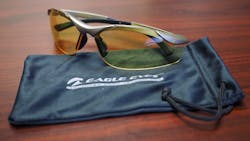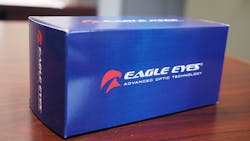Sixty bucks or less that can make you safer behind the wheel
Let me start by saying I disagree with Eagle Eyes about the use of their Night-Lite Night Driving Glasses—these really aren't only for nighttime. While helpful then, that may not even be their best use. I would simply call these "driving glasses."
These glasses have special non-polarized, yellow-tinted lenses designed to reduce glare and eyestrain in night driving conditions. They have a double-sided scratch-resistant coating and glare-resistant multicoating, and the yellow lenses filter out UV and blue light. They're supposed to cut down glare and improve night-driving visual acuity.
I tested out Eagle Eyes' Blade NL, which retails for $59.99. Other styles are available, including ones that clip onto or fit over glasses, starting at $30.95.
Let's get right to it: in my use, what stands out most is that the yellow "filter" you're putting in front of your eyes with these is a contrast equalizer. Extreme highlights and bright light are somewhat reduced, while darker areas are pumped up a bit.
After testing these out for some weeks in a number of different conditions, put simply, the Night-Lites level things out. It can be a very good thing behind the wheel.
They made me aware of driving-related eyestrain I didn't realize I had. I'd been driving in all kinds of conditions—overcast skies, nighttime, on a country byway under a canopy of trees, in broad daylight on a highway or in a city—not noticing the little flashes, glare, and flares of light that were frequently taking place.
To be fair, I should mention that I don't wear corrective lenses and almost never wear sunglasses; I don't like lenses that limit or obstruct my view.
And another thing... I'd say these may look a little (though not terribly) strange when you wear them. But that's a matter of opinion.
More importantly, driving with the Eagle Eyes on for a while and then taking them off, you'll notice. The difference is like going from a grayer, higher-contrast world to a more even-toned one in which those shadowy areas where you really aren't seeing much—like all those dark spots under trees or in foliage—suddenly reveal much more.
As I mentioned, I found these helpful for more than driving at night. My favorite use of the Night-Lites is on those nondescriptly overcast days where overhead it's just white or dull-bright gray and the skies seem to stretch on indefinitely. Pop these glasses on, and the Eagle Eyes will tone down that prismatic glare up above and brighten up the dimness below, where you're actually driving.
And just as helpful, I found, is using these glasses in a thunderstorm or inclement weather when visibility is dim and limited. They again seem to me to tone down the bright spots that occur, pump up the low or dark ones, and bring everything into more readily crisp view.
In their intended purpose, driving at night, they do help. They don't eliminate or much reduce the glare of oncoming headlights for me, which is a claim they make. But they do subdue the light and tone down the sharp eyestrain that those flares can produce, particularly with xenon and other high-intensity headlights available today.
And guess what? I find myself using these glasses in broad daylight at times as well. They may not be as necessary then, but they seem to have the same effect of balancing out high-low contrasts in a way that aids vision during driving. And I find myself reaching for them even then.
Once while driving to work on an overcast day, I wasn't wearing the glasses and suddenly noticed the various bright spots and many dark, shadowy areas that can create a see-saw of highs and lows. And I noticed the little moments of eyestrain it was producing that I suppose I'd grown used to before. I reached for the Eagle Eyes and noticed I'd left them at home.
"Daaaamn it!" I shouted, drawing out the phrase.
It should tell you something. I now keep the Eagle Eyes Night-Lites with me in my vehicle almost all the time, and find myself using them frequently when I'm behind the wheel—whether it's nighttime or not.
And not surprisingly, I've also found them a benefit in higher-risk driving situations like riding a motorcycle. Then, when you have to be extremely aware of other motorists, any mistakes or distracted actions they make, and obstacles/ obstructions on the road—not all that unlike truck drivers do—these glasses can be a lifesaver.
That's no joke. Once while riding on a 45-mph arterial highway thickly lined with trees and wearing the Night-Lites under my helmet, I spotted a number of deer running fast at the road while they were still well into the woods at the edge of my peripheral vision. The Eagle Eyes made the motion easy to spot.
I slowed down easily as they leapt into the road—directly and maybe inches in front of where I'd have been on my bike if I hadn't seen them.
You do your own math; these will stay with me. Check out Eagle Eyes' products at www.EagleEyes.com.
About the Author
Aaron Marsh
Aaron Marsh is a former senior editor of FleetOwner, who wrote for the publication from 2015 to 2019.


